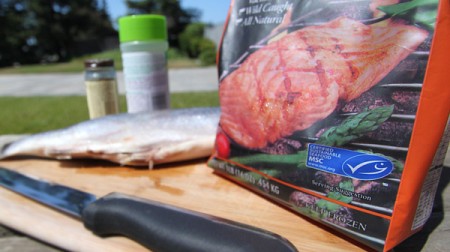Monday June 4, 2012
 With our increased awareness of the impact we can have on the world, the drive for a sustainable future becomes even stronger. Over the past few decades there has been growing concern about the availability of natural resources and it is the consumer who is responsible for influencing the revolution. There is now an overwhelming demand for products that have been certified as sustainably harvested and fishing industries around world are feeling the pressure. The increased demand has resulted in many fisheries taking it upon themselves to become certified.
With our increased awareness of the impact we can have on the world, the drive for a sustainable future becomes even stronger. Over the past few decades there has been growing concern about the availability of natural resources and it is the consumer who is responsible for influencing the revolution. There is now an overwhelming demand for products that have been certified as sustainably harvested and fishing industries around world are feeling the pressure. The increased demand has resulted in many fisheries taking it upon themselves to become certified.
A wide range of different groups govern the way that ocean fisheries are managed and all are working toward the same goal of ensuring that the fish we consume are there for generations to come. Given these differing management approaches, it can be difficult to determine which standards are applied to which fisheries. The Marine Stewardship Council (MSC) is a group that has filled this gap by creating a standard for what they consider a “sustainable” fishery. MSC is a non-profit group that was started in 1996 by the World Wildlife Fund (WWF) and Unilever with the goal of changing the way fish are caught, marketed, and bought. Today there are 105 fisheries around the world that have been certified as sustainable to MSC standards, which include 56 different species such as sardines, lobster, swordfish and crab. The fisheries are both large, for example the certification of five species of Alaskan Salmon, and small, like the fishery for Lyrate hard clams in the Ben Tre Province of Vietnam. It is important to distinguish that this doesn’t mean that every sardine, lobster, swordfish, or crab caught has been certified sustainable. If you want to be certain you are purchasing something MSC certified, it is your responsibility to make sure that the fish you buy has the label.
In order to obtain a sustainable fishery label from the MSC the fishery must first pass a rigorous seven-step assessment conducted by a qualified certifier. The average time that it takes to conduct the assessment is 18 months, but it can vary based on how much information is already available on the fish stocks and how much more research is needed to conduct a proper study for determining if the fishery is sustainable. A pre-assessment can help inform the fishery regarding how close they are to meeting the standards and to identify any potential issues with the fishery performance before jumping into a full-scale assessment. The three main principles that are assessed by the MSC for determining certification are;
- the fishery’s ability to maintain a sustainable fish population,
- whether or not the fishery is damaging the ecosystem in which it depends on,
- and that it is managed in a way that complies with all local, national, and international laws.
Once the fishery meets the MSC standards, the certificate of sustainability will be valid for five years, as long as the fishery continues to pass a yearly review to verify that it is meeting the standards. At the end of the five-year period, another full assessment of the fishery will be conducted.
In 16 years our cultural awareness of the adverse effects we have had on world fisheries, and the collective efforts made by the Marine Stewardship Council and other similar sustainable seafood organizations, have significantly influenced the way the fisheries are managed today. As of 2011, roughly 6% of all wild caught seafood has been certified by MSC’s standard and with your help that number could continue to rise. If society makes a collective effort to buy sustainable seafood then the world’s fisheries will continue to see the benefits and make the efforts to move towards sustainable fishing.
